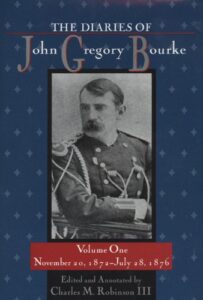Writers Richard Bourke, Leonard Marcisz and Donald Hadder, Sr.



On March 14, 1873, John Gregory Bourke departed from Camp McDowell and led an expedition through what is now known as McDowell Mountain Regional Park and the McDowell Sonoran Preserve. While camping at Cave Creek, he charted his travels in his personal journal — a map that would become the very first recording of some of our community’s most notable geographic features, including Cone, Brown’s and Black mountains.
A true renaissance man, Bourke’s contributions to our state and our country began years earlier when, at just 16 years old, he enlisted in the Union Army during the Civil War. Still a teenager, he was awarded the Medal of Honor for gallantry at the battle of Stones River, Tennessee. Having impressed his superior officers, he was recommended for admittance to the United States Military Academy at West Point, graduating in 1869.
By September 1871, Bourke was named aide-de-camp to Gen. George Crook, for whom Arizona’s Crook Trail is named. He accompanied Crook through the early Arizona Apache campaigns; the Sioux and Cheyenne campaigns on the northern plains; and the closing Apache campaign in Arizona and Mexico, which involved the pursuit of the Apache leader Geronimo.
While Crook is well known among popular historians, makers of Western movies and the interested public, his indispensable lesser-known aide, Bourke, maintains a following among serious Western historians, anthropologists and ethnographers.
In November 1872, Bourke began keeping personal daily journals, such as those that delineated the features of what would eventually come to be known as Brown’s Ranch. These writings — of which there are 124 manuscript volumes held at West Point — are considered invaluable original sources and research documents by Western historians.
Granted time off from military duties, Bourke lived among and studied Native American cultures. A language scholar, he learned to speak Apache in order to further his studies. An authority regarding anthropological studies of southwestern cultures, he was elected to the Association for the Advancement of Science and Anthropological Society of Washington in the mid-1880s.
A prolific author, Bourke’s books include “On the Border with Crook,” “An Apache Campaign in the Sierra Madre,” Apache Medicine Men” and “The Snake Dance of the Moquis (Hopis) of Arizona.”
In 1885, Bourke began a campaign for equitable treatment of Native Americans, publicly denouncing the U.S. government’s Indian programs. He advocated keeping the Chiricahua Apache in Arizona rather than removing them to exile in Florida.
He was also an opponent of sending Native American children to off-reservation Indian schools, stating, “Much of our trouble with these tribes could have been averted had we shown what would appear to them as a spirit of justice and fair dealing.”
In June 1896, at age 49, Bourke passed away from an aneurysm of the aorta. Interred at Arlington National Cemetery, his spirit lives on in the Western landscape, customs and culture for which many of us choose to call this area our home.







Comments by Admin